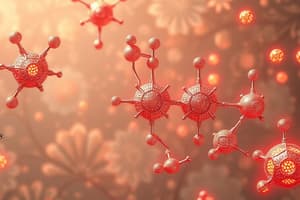Podcast
Questions and Answers
How many covalent bonds does carbon typically form to achieve an octet of valence electrons?
How many covalent bonds does carbon typically form to achieve an octet of valence electrons?
- Three
- Five
- Six
- Four (correct)
What is the purpose of sharing electrons through covalent bonding for elements like nitrogen, oxygen, and the halogens?
What is the purpose of sharing electrons through covalent bonding for elements like nitrogen, oxygen, and the halogens?
- To gain valence electrons
- To lose valence electrons
- To achieve a duet of valence electrons
- To achieve an octet of valence electrons (correct)
What is the typical number of covalent bonds formed by nitrogen through sharing its valence electrons?
What is the typical number of covalent bonds formed by nitrogen through sharing its valence electrons?
- Four
- Two
- Three (correct)
- One
How many valence electrons do hydrogen and helium have in common?
How many valence electrons do hydrogen and helium have in common?
What is the purpose of the octet rule in covalent bonding?
What is the purpose of the octet rule in covalent bonding?
What is the typical number of valence electrons left unshared as electron pairs for oxygen?
What is the typical number of valence electrons left unshared as electron pairs for oxygen?
How many nonbonding pairs of electrons are assigned to the fluorine atom in the Lewis structure of CH3F?
How many nonbonding pairs of electrons are assigned to the fluorine atom in the Lewis structure of CH3F?
What is the total number of valence electrons represented by the bonding pairs in the Lewis structure of CH3F?
What is the total number of valence electrons represented by the bonding pairs in the Lewis structure of CH3F?
What is the main difference between dash structural formulas and condensed structural formulas?
What is the main difference between dash structural formulas and condensed structural formulas?
What is the purpose of writing resonance structures?
What is the purpose of writing resonance structures?
What is a characteristic of resonance structures?
What is a characteristic of resonance structures?
What is the rule for writing resonance structures?
What is the rule for writing resonance structures?
What is the symbol used to connect resonance structures?
What is the symbol used to connect resonance structures?
What is the advantage of using condensed structural formulas?
What is the advantage of using condensed structural formulas?
What is a characteristic of condensed structural formulas?
What is a characteristic of condensed structural formulas?
Why are resonance structures drawn?
Why are resonance structures drawn?
What is the first step in writing a Lewis structure for a molecule?
What is the first step in writing a Lewis structure for a molecule?
What is the purpose of using unshared electron pairs in a Lewis structure?
What is the purpose of using unshared electron pairs in a Lewis structure?
What is the total number of valence electrons used so far in the given example?
What is the total number of valence electrons used so far in the given example?
Which of the following statements is true about the valence shells of the atoms in the given example?
Which of the following statements is true about the valence shells of the atoms in the given example?
What is the purpose of the octet rule in writing Lewis structures?
What is the purpose of the octet rule in writing Lewis structures?
How many electrons are left to use after forming the bonds between the hydrogen atom and the carbon atom, and the carbon atom and the nitrogen atom?
How many electrons are left to use after forming the bonds between the hydrogen atom and the carbon atom, and the carbon atom and the nitrogen atom?
What is the electronic structure of the hydrogen atom in the Lewis structure of hydrogen cyanide (HCN)?
What is the electronic structure of the hydrogen atom in the Lewis structure of hydrogen cyanide (HCN)?
What is the bond between the carbon atom and the nitrogen atom in the Lewis structure of hydrogen cyanide (HCN)?
What is the bond between the carbon atom and the nitrogen atom in the Lewis structure of hydrogen cyanide (HCN)?
What is the formal charge of an atom in a molecule calculated as?
What is the formal charge of an atom in a molecule calculated as?
What is the arithmetic sum of all the formal charges in a molecule or ion equal to?
What is the arithmetic sum of all the formal charges in a molecule or ion equal to?
What is the symbol used to represent the formal charge?
What is the symbol used to represent the formal charge?
What does the number of unshared electrons represent in the formal charge equation?
What does the number of unshared electrons represent in the formal charge equation?
What is the purpose of calculating formal charges?
What is the purpose of calculating formal charges?
What is the relationship between the number of shared electrons and the formal charge?
What is the relationship between the number of shared electrons and the formal charge?
What is the purpose of the equation F = Z - (1/2)S - U?
What is the purpose of the equation F = Z - (1/2)S - U?
What does the symbol Z represent in the formal charge equation?
What does the symbol Z represent in the formal charge equation?
What is the first step in writing a Lewis structure for a molecule?
What is the first step in writing a Lewis structure for a molecule?
What is the purpose of using multiple bonds in Lewis structures?
What is the purpose of using multiple bonds in Lewis structures?
How many electron pairs are used to form single bonds between the carbon and hydrogen atoms in the Lewis structure of methylamine (CH3NH2)?
How many electron pairs are used to form single bonds between the carbon and hydrogen atoms in the Lewis structure of methylamine (CH3NH2)?
What is the final step in writing the Lewis structure of methylamine (CH3NH2)?
What is the final step in writing the Lewis structure of methylamine (CH3NH2)?
How many valence electrons are used to form single bonds between the nitrogen atom and hydrogen atoms in the Lewis structure of methylamine (CH3NH2)?
How many valence electrons are used to form single bonds between the nitrogen atom and hydrogen atoms in the Lewis structure of methylamine (CH3NH2)?
What is the purpose of finding the total number of valence electrons in a molecule?
What is the purpose of finding the total number of valence electrons in a molecule?
In writing the Lewis structure of a molecule, what should be done if necessary?
In writing the Lewis structure of a molecule, what should be done if necessary?
What is the correct order of steps in writing a Lewis structure?
What is the correct order of steps in writing a Lewis structure?
Flashcards are hidden until you start studying
Study Notes
How to Write and Interpret Structural Formulas
- Dash structural formulas show bonding electron pairs and include elemental symbols for all atoms in a molecule.
- Condensed structural formulas write all hydrogen atoms attached to a particular carbon immediately after the carbon.
- The condensed formula for isopropyl alcohol can be written in four different ways.
Rules for Writing Resonance Structures
- Resonance structures exist only on paper and are used to describe molecules and ions for which a single Lewis structure is inadequate.
- Resonance structures are connected by double-headed arrows (←→) and the real molecule or ion is a hybrid of all of them.
- Only electrons can be moved in writing resonance structures, not the positions of the nuclei of the atoms.
- Hydrogen forms one covalent bond by sharing its electron with an electron of another atom.
- Carbon forms four covalent bonds by sharing its four valence electrons with four valence electrons from other atoms.
- Nitrogen, oxygen, and the halogens typically share only some of their valence electrons through covalent bonding, leaving others as unshared electron pairs.
Writing Lewis Structures
- To write a Lewis structure, find the total number of valence electrons of all the atoms.
- Use pairs of electrons to form bonds between all atoms that are bonded to each other.
- Add the remaining electrons in pairs to give each hydrogen 2 electrons (a duet) and every other atom 8 electrons (an octet).
Exercises
- Write a Lewis structure for CH3F:
- Find the total number of valence electrons of all the atoms.
- Use pairs of electrons to form bonds between all atoms that are bonded to each other.
- Add the remaining electrons in pairs to give each hydrogen 2 electrons and every other atom 8 electrons.
- Write a Lewis structure for methylamine (CH3NH2):
- Find the total number of valence electrons for all the atoms.
- Use one electron pair to join the carbon and nitrogen.
- Use three pairs to form single bonds between the carbon and three hydrogen atoms.
- Use two pairs to form single bonds between the nitrogen atom and two hydrogen atoms.
- Leave one electron pair as a lone pair on the nitrogen atom.
- Write a Lewis structure for CH3OH:
- Use multiple bonds to satisfy the octet rule (i.e., give atoms the noble gas configuration).
- Write a Lewis structure for CH2O (formaldehyde):
- Find the total number of valence electrons of all the atoms.
- Use pairs of electrons to form single bonds.
- Determine which atoms already have a full valence shell and which ones do not.
- Use the remaining electrons as bonds or unshared electron pairs to fill the valence shell of any atoms whose valence shell is not yet full.
Formal Charges
- The formal charge is the number of valence electrons minus 1/2 the number of shared electrons minus the number of unshared electrons.
- The arithmetic sum of all the formal charges in a molecule or ion will equal the overall charge on the molecule or ion.
- Calculate the formal charge using the formula: F = Z - (1/2)S - U.
- Exercises:
- Calculate the formal charge of the ammonium ion.
- Calculate the formal charge of the nitrate ion.
- Calculate the formal charge of water.
- Calculate the formal charge of ammonia.
A Summary of Formal Charges
- Formal charges are used to determine the overall charge of a molecule or ion.
- The formal charge is calculated using the formula: F = Z - (1/2)S - U.
Studying That Suits You
Use AI to generate personalized quizzes and flashcards to suit your learning preferences.




